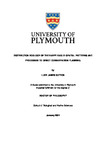Distribution ecology of the harpy eagle: spatial patterns and processes to direct conservation planning
| dc.contributor.supervisor | Puschendorf, Robert | |
| dc.contributor.author | Sutton, Luke James | |
| dc.contributor.other | School of Biological and Marine Sciences | en_US |
| dc.date.accessioned | 2021-04-29T10:24:23Z | |
| dc.date.available | 2021-04-29T10:24:23Z | |
| dc.date.issued | 2021 | |
| dc.date.issued | 2021 | |
| dc.identifier | 10522025 | en_US |
| dc.identifier.uri | http://hdl.handle.net/10026.1/17078 | |
| dc.description | Peer-reviewed publication resulting from this thesis: Sutton, L.J., Anderson, D.L., Franco, M., McClure, C.J.W., Miranda, E.B., Vargas, F.H., Vargas González, J. de J. & Puschendorf, R. (2021). Geographic range estimates and environmental requirements for the harpy eagle derived from spatial models of current and past distribution. Ecology & Evolution. 11: 481-497. DOI: https://doi.org/10.1002/ece3.7068 | en_US |
| dc.description.abstract |
Accurately demarcating species distributions has long been at the core of ecology. Yet our understanding of the factors limiting species range limits is incomplete, especially for tropical species. Human-driven threats to the survival of many taxa are increasing, particularly habitat loss and climate change. Identifying distributional range limits of at-risk species can thus inform spatial conservation planning to mitigate these threats. The harpy eagle (Harpia harpyja) is a large raptor distributed across Neotropical lowland forests, from southern Mexico to northern Argentina, currently threatened by habitat loss and persecution. Coupled with climate change, harpy eagle distribution may contract or shift leading to uncertainty on its future conservation. Here, I use point process regression models and ordination to identify harpy eagle environmental range limits and recommend spatial conservation planning measures for the species. I propose a revised range size 11 % smaller and an Extent of Occurrence 26 % less than the current estimates. By including biotic interactions in model predictions, I show that prey resources are more important for limiting harpy eagle distribution than climatic conditions. When compared to crested eagle (Morphnus guianensis) distribution, the harpy eagle’s primary competitor, both species shared identical habitat resource space, with only subtle differences in distribution. Range-wide habitat use indicated that harpy eagles prefer areas of 70-75 % evergreen forest cover, low elevation and high vegetation heterogeneity, but avoid cultivated land, mosaic forest and complex topography. The current Important Bird and Biodiversity Area (IBA) network covered 17 % of medium to high harpy eagle habitat exceeding the protected area target representation (10 %). Under a future high emissions climate change scenario, range size was predicted to decrease by 14.4 % by 2090, with the IBA network covering 14 % less of its current coverage. Despite its large range, the harpy eagle has specialized habitat requirements and would benefit from targeted conservation measures based on spatial models in order to maintain viable populations. | en_US |
| dc.description.sponsorship | The Peregrine Fund | en_US |
| dc.language.iso | en | |
| dc.publisher | University of Plymouth | |
| dc.rights | Attribution-ShareAlike 3.0 United States | * |
| dc.rights.uri | http://creativecommons.org/licenses/by-sa/3.0/us/ | * |
| dc.subject | Biogeography | |
| dc.subject | Species distribution models | |
| dc.subject | Habitat use | |
| dc.subject | Conservation planning | |
| dc.subject | Spatial ecology | en_US |
| dc.subject.classification | PhD | en_US |
| dc.title | Distribution ecology of the harpy eagle: spatial patterns and processes to direct conservation planning | en_US |
| dc.type | Thesis | |
| plymouth.version | publishable | en_US |
| dc.identifier.doi | http://dx.doi.org/10.24382/459 | |
| dc.rights.embargoperiod | No embargo | en_US |
| dc.type.qualification | Doctorate | en_US |
| rioxxterms.version | NA | |
| plymouth.orcid.id | 0000-0003-0971-4619 | en_US |
Files in this item
This item appears in the following Collection(s)
-
01 Research Theses Main Collection
Research Theses Main



